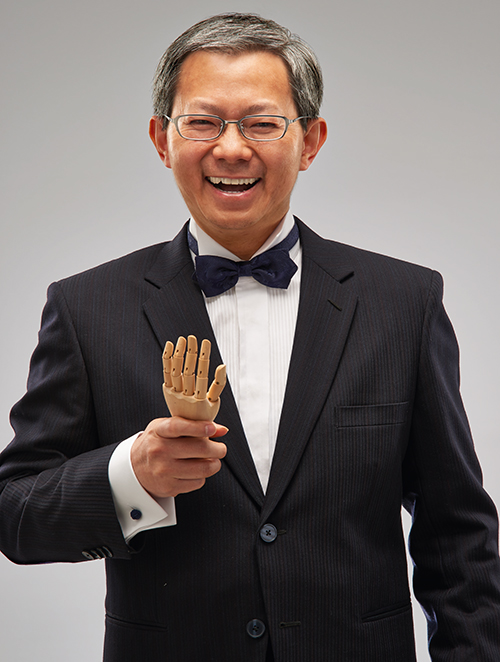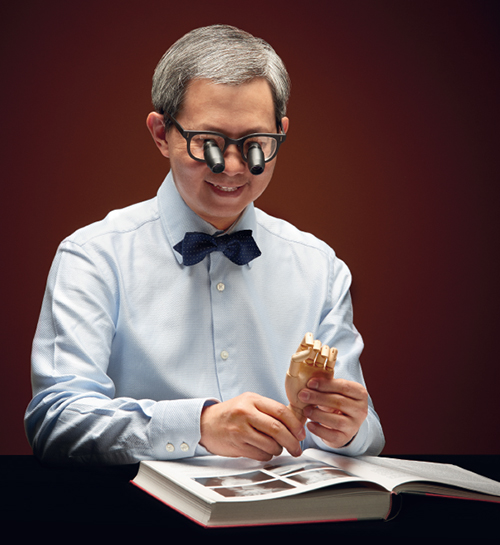With a structure as intricate, small and functional as the hand, it is no surprise that when disease or injury strikes, surgery to fix the problem requires great calm, steadiness and a steely focus on the part of the surgeon.
Here, THIS Quarterly speaks to Hand Surgeon Dr Tan Soo Heong to find out what it takes to achieve such precision and control during the quietly gruelling process of hand microsurgery.
The Hand – Crucial Yet Underrated
While most of us do not think much of our hands and take them for granted, Dr Tan believes that the hand is a masterpiece of perfect engineering, and each integral component of the hand has its own specialised contribution to the overall function of the hand.
However, this highly intricate nature of the hand that gives us such versatile and strong motions, also gives us vulnerability. Dr Tan explains,
“The harmony of tissues that make up the hand is very easily disrupted by diseases and injuries, and when that happens, the things that we do every day with our hands – and often without conscious thought – become monumental obstacles or impossibilities.”
What It Takes to Fix the Hand
As hand surgery treats disorders that affect optimal functioning of the hand, hand surgeons often treat patients with stroke and cerebral palsy, as well as patients with hand injuries caused by birth trauma, accidents and congenital malformations.
Dr Tan elaborates, “Hand surgery also involves reconstructive microsurgery involving the replantation of amputated digits, hands and upper limbs, as well as microsurgical free tissue transfer surgery that involves the transfer of skin, muscles, nerves and bones to repair and reconstruct the hand.”
With the components of the hand so small and intricate, hand surgery is considered microsurgery, which is when “structures are microscopic in size and are stitched with sutures finer than a strand of hair.” This also means that should the surgeon not have an intense focus and a steady pair of hands, even the slightest tremble will be akin to an earthquake under the microscope, making microsurgery impossible. “Crushing tissues with forceps and surgical instruments will result in more scarring with resultant motion restriction”, says Dr Tan, emphasising the importance of the ability to attain a Zen-like state of mind in hand surgery after years of experience. And of course, he says, there is always music in the background during the surgeries he performs.

The Starting Point & Career Milestones

Dr Tan’s interest in the lesser-known specialty of hand surgery was first kindled when, as a doctor in training, he was posted to the Hand Surgery department at the Singapore General Hospital, which was then led by Professor Teoh Lam Chuan. “They were very dedicated and passionate about hand surgery, and their ability to meticulously plan, organise and reconstruct a severely injured hand so that the patient could regain its use was inspirational”, Dr Tan recounts. It was then when the budding doctor found his calling.
Dr Tan then went on to receive a prestigious scholarship from the Japanese government to further his training on Hand & Reconstructive Microsurgery with Professor Kazuteru Doi. This turned out to be a rigorous and valuable experience that tested and built up his physical and mental stamina. “Working and training there built up a certain resilience and endurance for long complex surgeries. Complicated reconstructive procedures can last as long as 12 hours or more!” says Dr Tan.
This was then followed by what Dr Tan describes as a “high career point” – a year-long stint at the world-renowned Kleinert Kutz Hand Care Center in the US, a result of being awarded a Ministry of Health Fellowship for Hand and Advanced Reconstructive Microsurgery. The first hand transplant in the US was done there and Dr Tan was privileged to be involved in the second.
The humble and quietly passionate doctor reflected, “Imagine the magnitude of this for the patient, and all his hopes and dreams.”
Improving Patient Outcomes
Advancements in technology and knowledge have fortunately allowed hand surgeons to give hope to many patients with devastating injury. The brachial plexus, for example, is a network of important nerves in the neck that controls sensation and movements of the upper limb and hand. Hence, patients with brachial plexus injuries caused by birth trauma or accidents will lose sensation and control of their upper limbs.
“In the past, treatment for this condition was to get rid of the useless part by amputation. With complex reconstructive microsurgery, we can now reanimate the hand and upper limb to restore functional use of the upper limb again”, says Dr Tan.
He also identified two key developments that are shaking up the field of hand surgery, namely 3D printing and robotics.
3D printing will allow personalised surgery. “Right now, implants only come in several standard sizes, with body parts having to be altered in surgery to fit the implants”, Dr Tan says. With 3D printing, however, the body part can now be scanned and a custom-made implant can be produced based on the patient’s measurements.
With regard to robotics, Dr Tan explains that “robotics-assisted devices can help in rehabilitation to monitor and assist in hand therapy and upper limb training.” Ingenious purposes include software programmed to train patients in therapy and daily life activities, and the use of myoelectric currents in the arm or shoulder to allow prosthetic limbs to function like a normal hand.
Apart from technological advancements improving patient care, hand surgeons are also intimately involved with patients at every step of their recovery. As Dr Tan points out,
“Some patients become discouraged when they can’t do the everyday things they usually do during the recovery period. That’s when we need to cajole, encourage and motivate them. This is really important because highly motivated patients will usually have excellent results!”








